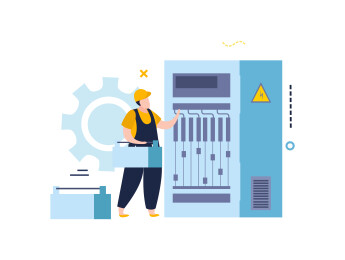Power systems are now essential to the effective running of businesses and households and it’s incredibly important to ensure contingency plans and safety procedures are implemented correctly in the event of an outage.
A power system protection scheme needs to be put into place to ensure that all devices, fuses, relays, and circuit breakers don’t fail or have a backup to maintain an effective energy supply and service.
For this reason, operational support, technicians, and engineers working in the power plant or energy field need to have advanced knowledge and skills regarding utility switching processes, load transfers, and investment policies, meaning that power can be supplied easily and within budget.
IEDs or Intelligent Electronic Devices are the most cost-effective way to highlight and diagnose problems using systemised logic and communication techniques. For those who are required to handle faults and problems and learn lessons from the consequences, understanding the IED language is an essential skill.
Upon completion of this course, participants will be able to:
- Recognise key faults and calculate solutions.
- Understand the key fundamental elements of a power system.
- Diagnose relay and circuit problems.
- Protect your operation from downtime.
- Devise contingency plans based on lessons learned and risk areas.
- Coordinate a protection device and protocol as a backup.
- Analyse the most appropriate and cost-effective protection system for your needs.
- Establish advanced communication methods between your protection devices and your employees.
- Understand the uses for generators, transformers, motors, and transmission lines and develop an index of potential risks.
This training is suitable for anyone involved in the operational planning of power systems or the technical protection of systems to preserve energy at the lowest cost for the highest return on investment. However, it would be most beneficial for:
- Engineers.
- Operations Managers.
- Project Managers.
- Technicians.
- Design Engineers.
- Asset Managers.
- Planning & Performance Personnel.
- Health & Safety Commissioners.
This course is presented using a variety of adult learning techniques and methods including informative slideshow presentations displaying the common risk areas and equipment uses, group activities to identify cost-effective methods of contingency and real-world case studies to aid understanding of the best power protection services.
Day 5 of each course is reserved for a Q&A session, which may occur off-site. For 10-day courses, this also applies to day 10
Section 1: The Role of Relaying Protection
- Why is relay protection important?
- The protection zones according to time current.
- What you need to look out for.
- Your cost-benefit analysis.
- Grounded vs. ungrounded protection.
- Modern software uses for essential protection.
Section 2: Protective Devices
- CT and VT specifications and applications.
- Different fuse types and what will work for you.
- Selection and sage coordination of fuses.
- Digital relays.
- Numerical relays.
- The characteristics of feeder protection.
Section 3: Theoretical Concepts, Equations & Calculations
- IDMT O/C & E/F protection.
- Definite time protection.
- REF and DIFF.
- Buchholz pressure relief methods.
- Application of Programmable Logic Controllers (PLC).
- Ground-level calculations.
Section 4: Earth Fault Protection
- High-set and instantaneous protection.
- Relay setting and what they mean.
- Transient overreach.
- Transformer unit protection.
- Unit vs. non-unit protection.
- Transformer protection and complex solutions.
Section 5: Analysis and Design of Protection
- Auditing and assessment.
- Record-keeping and lessons learned.
- Devising the appropriate level of protection.
- Safety features and processes.
- Creating a contingency plan.
- Calculating feeder overcurrent protection requirements.
Section 6: The Capability Curve
- Assessing generator faults.
- Creating specific generator protection.
- Biased and unbiased differentials.
- The capability curve and interpretations.
- Bus protection limits and requirements.
- Testing and re-testing.
Section 7: Overhead Lines & Busbar Protection
- Busbar protection schemes.
- High impedance protection.
- Looking out for frame leakage.
- Line distance protection.
- Differential protection and methods of switching.
- The application of static capacitors and non-utility generators.
Section 8: Operational Changes and Power System Switching
- Project planning and switching.
- Risk assessments and contingency planning.
- The effects of potential ground rising.
- The possible effects on telecommunications equipment.
- Budgeting and assessing your return on investment.
- How will your chosen protection scheme benefit you?
- What you need to consider for the future.
Upon successful completion of this training course, delegates will be awarded a Holistique Training Certificate of Completion. For those who attend and complete the online training course, a Holistique Training e-Certificate will be provided.
Holistique Training Certificates are accredited by the British Assessment Council (BAC) and The CPD Certification Service (CPD), and are certified under ISO 9001, ISO 21001, and ISO 29993 standards.
CPD credits for this course are granted by our Certificates and will be reflected on the Holistique Training Certificate of Completion. In accordance with the standards of The CPD Certification Service, one CPD credit is awarded per hour of course attendance. A maximum of 50 CPD credits can be claimed for any single course we currently offer.
- Course Code IND04-103
- Course Format Classroom, Online,
- Duration 5 days











